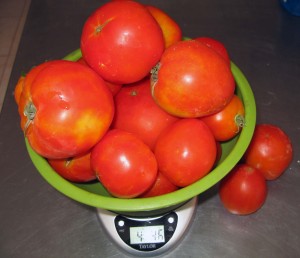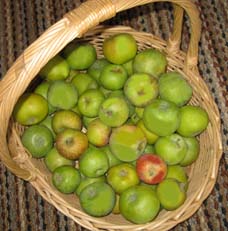“It’s difficult to think anything but pleasant thoughts while eating a homegrown tomato.”
–Lewis Grizzard
On July 2, I picked my first ripe tomato of the season, weighing in at three-quarters of a pound. I have a total of 18 tomato plants, several purchased as seedlings from my local garden center and the rest sprouted from heirloom seeds I bought mail-order for last year’s garden. Last year I got no tomatoes by the first week of August and blamed the heirloom seeds, then pulled up the plants because I was tired of fretting over them. I have learned several things since then.
1. Be patient. When starting from seeds, it can take a while for plants to mature
2. One yard may have several varieties of soil; some areas may be much healthier than other areas. Mine is toxic in some places and capable of producing prize winning produce in other areas, specifically where I sowed wildflowers two years running (note blog photo), but then stopped because it was attracting every gopher within a quarter mile radius and that’s a lot of gophers in this neighborhood.
3. If planting several different varieties, tag them so you will know what you are harvesting. I didn’t and don’t.
4. Water as regularly and evenly as possible; otherwise the tomatoes may split along the top by soaking up too much water at one time. The split portions will need to be cut out (and you can’t barter split tomatoes).
5. Use a non-hazardous pesticide when dealing with tomato worms. I have a variety that claims to be safe to use on pets so I expect it is safe for humans but the tomato worms bite the dust. It’s easy to tell when a tomato worm is at work as it will start stripping the plant of leaves and will eventually strip it bare if to its own devices. On closer inspection you will detect black droppings. However, I can never spot the actual ugly, green-horned tomato worm; it blends in so perfectly with the plant.
6. It’s not necessary to plant tomatoes in raised beds as nothing bothers the plants (except the tomato worm in my experience) so it’s a waste of space that could be better used for other crops. Do not plant too close together and do not plant too close to buildings. These points may seem obvious but it’s all stuff I learned this year.
7. If you plant in several areas you will need to water in several areas. I know this seems self explanatory but it’s not something I thought about in advance, but only as I’ve had to water five different areas around the side and rear of my house.

Four tomato plants too close together and too close to the white gardening shed so there is no room to get behind them.
Last week I weighed the bounty in my vegetable drawer and discovered I had accumulated seven pounds of ripe tomatoes. I thought about bartering with our local organic veggie vendor who puts in an appearance at the White Barn every weekend. But I promised myself when I decided to seriously garden that I would consume as much as I could and preserve as much as I thought I would use in six or eight months, first by drying and then by canning. But tomatoes have such a heavy water content they are a nuisance to dry even though tomatoes are much more flavorful after the water is removed through drying. I especially like using them on homemade pizza.
So I passed on the veggie vendor this week and despite a predicted high of 101 degrees, decided to water-bath can my tomatoes. My kitchen in this 130-year-old house is not air conditioned and fans only help circulate hot air. It was only 98 according to my kitchen wall thermometer when I was canning. I ended up with eight pints of home-canned tomatoes.
I must say it feels truly virtuous to not only grow, but parboil, peel, chop and can your own organic vine-ripened tomatoes, especially at sauna temperatures. (And I confess I usually do cooking projects closer to sunrise when the kitchen is still cool.)
Come winter I’m looking forward to some homegrown, homemade tomato soup (with no extra sodium or preservatives) as well as spaghetti sauce, homemade chili, etc. here in the backcountry.
P.S. Have harvested another seven pounds this week so it’s back to the waterbath canning tomorrow morning when the weather will be much cooler.









